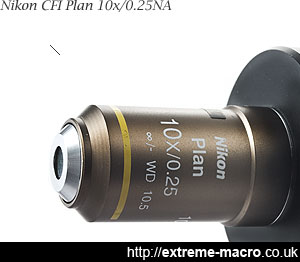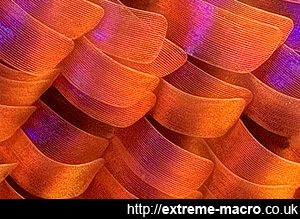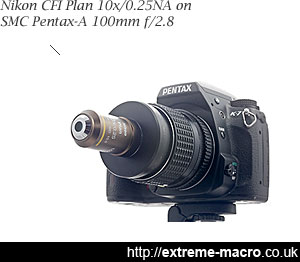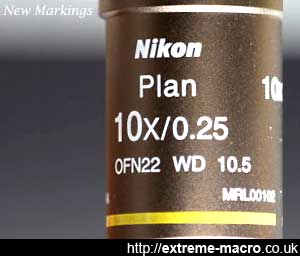Nikon CFI Plan 10x Objective ∞
by Johan J Ingles-Le Nobel
Last updated August 31, 2017
Nikon is one of the big names in microscopy, and has a vast range of microscopes and objectives which includes the Nikon CFI Plan 10x/0.25NA 10.5mm WD Objective, ideal for extreme macro focus stacking in the 5:1-10:1 range. The biggest single advantage of this optic is not image resolution or sharpness, but the allround package with a longer than average working distance. It is not a Mitutoya 10x which is a scale beyond other 10x objectives, but it is a decent allround performer that can reliably be expected to give a very decent level of performance.

Nikon CFI Plan 10x/0.25NA 10.5mmWD objective, material no. MRL00102. Shown with its outer brown casing, which I actually usually just remove to give a little more room for light to make its way down to the specimen. The Nikon CFI Plan 10x objective is well known in the photomacrography community to be a very decent performer in the 5x to 10x range; expect to pay about £100 for a new copy.
This Nikon 10x CFI plan achromat is not only outstanding at 10:1 with a 200mm tube lens on APSC, but because it has such a nice large image area it can also be a wickedly sharp 5:1 with a 100mm tube lens.
5:1 -10:1 Extreme Macro
Beyond 5:1 on an APSC sensor, certain 10X infinite objectives taken down to 5:1 by using a 100 mm tube lens become the optic of choice. Nikon and Mitutoyo can both be used in this way to provide a 5X NA 0.25 combo (NA 0.28 for the Mitutoyo).
Objectives with similar sharpness and specifically designed for 5:1 can be purchased, but they are very expensive and hard to come by. That said, let's face it, Mitutoyo is not exactly cheap.
wickedly sharp 5:1 with a 100mm tube lensMicroscope objectives used between 1:1 - 5:1 magnification tend to give poor corners, even on APSC cameras; the exception being the Mitutoyo 5/0.14. This gives a very good performance on full frame cameras and could be used at 3:1 on APSC.
Infinity Objectives

Nikon objective with a Raynox as the tube lens make a fine combination, revealing a staggering amount of detail in the extreme macro and micro world. Be aware that some objectives require CA correction in the eyepiece and are not suitable for micro photography - do your research!
An infinity objective is a model objective that is designed to be used in connection with another lens, a tube lens, also known as relay lens. For extreme macro, a tube lens can be a standard non macro telephoto lens: macro lenses tend to be optimised for nearby focus and can have quite far recessed front lenses. Zooms also work but use them at the long end. Dedicated tube lenses are also available.
The German microscope manufacturer Reichert started experimenting with infinity corrected optical systems in the 1930s and was followed later by Zeiss and Leica, but did not become commonplace until the 1980s.
The microscopy benefit of using infinity corrected optics is that parfocality between different objectives can be maintained, even when one or more auxiliary components (such as illuminators or polarizers) are added into the optical path. This is useful for photography too - it means we can stick stuff in between. Like a nice iris.
Using A Telephoto Lens As A Tube
- Set the telephoto aperture wide open
- Focus the telephoto at infinity
- Primes generally perform better than zooms
- But zooms can be fine if used at long end
- Distance between tube and objective matters
- Telephoto lens better then a macro lens
Infinity objectives act like a magnifying glass, forming a virtual image at infinity. In this virtual image, each point on the subject is represented by parallel rays, similar to a landscape photograph which also presents itself to your eye as parallel rays.
The tube lens then acts like a camera lens, taking these parallel rays coming and focusing them to form a real image on the sensor. This contrasts with the older style finite objectives, in which the objective forms an image just by itself.
effective f-number = magnification/(2*NA)An advantage for extreme macro is that many finite objectives rely on corrective eyepieces and will have degraded image quality when mounted on a DSLR lens (which lacks the correction in the eyepiece). Many newer infinity lenses do not rely on this and have good performance in this setup. However, some are designed to have corrective tube lenses, and this is not always obvious before purchase, so you should definitely check and do your homework first.
Different Tube Lenses

Nikon CFI Plan 10x/0.25NA 10.5mm Working Distance objective mounted on a SMC Pentax-M 100mm f/2.8 tube lens. Annoyingly, the only available Nikon CFI Plan adapter comes in a 52mm size, so I have to use another adapter to bring it down to the Pentax 49mm thread.
Changing the tube lens focal length scales the magnification and coverage in proportion to the length. The numerical aperture does not change, so using a Nikon CFI 10x objective on a 100mm tube gives 5:1.
When used this way, the Nikon CFI 10x objective will still cover an APSC-sized sensor, but the Mitutoyo will not. Both objectives cover APSC on a 135mm tube, and give 6.75:1. You don't want to go under 100mm for a tube lens as this may give vignetting in the corners.
Prime (fixed focal length) as opposed to zoom lenses are better for image quality. Opinions very, but I've found that the quality of the tube lens is not a massive concern, because the objective stops down the whole system to have an effective f-number = magnification/(2*NA). For example 10X NA 0.25 means effective f/20.
Amazingly, Raynox diopters also make a fine tube lens. Zoom lenses are perfectly fine if used with infinity objectives when zoomed out to their maximum, but beware that they are likely to vignette if they are used at less than maximum length.
Attaching The Objective
When attaching the objective to the lens, I've found it better to keep it close so that the light goes through the centre of the lens, the optically best bits. This helps image quality in the image corners and makes sure to avoid vignetting.
objectives used between 1:1 - 5:1 magnification tend to give poor cornersOn the flipside, if your image ends up with a lot of contrast loss, then maybe your objective is too close to the tube and stray light is bouncing between them. So there is a compromise to be made here, trial end error is your friend.
The space between the objective and the tube is known as the 'infinity space'. It is nice when the maximum allowable infinity space is big enough (as it can be with some tube lenses) to have the opportunity to use an iris diaphragm.
Nikon CFI Adapters
The adapter to mount this objective in front of a telephoto lens is commercially available on eBay as "Nikon CFI M25 microscope objective to M52 52mm adapter". Before buying though, double check with the seller, as Nikon CFIs do come in 25mm, 26mm and 27mm threads, and the wrong adapter is easily purchased. Speaking from personal experience.
OFN22

Nikon CFI 10x - new markings in 2014
As of early 2014, it appears that this objective now has different markings: "Nikon Plan 10x/0.25 OFN22 WD 10.5 MRL00102 MADE IN CHINA". It has the same material number so you'd think it's the same construct, but this OFN22 is a bit mysterious as there are other CFI Plan objectives now on eBay marked OFN25 (ie Nikon CFI Plan Apo VC 20X DIC N2 OFN25 WD 1.0), and the CFI Plan set have always been marketed as having "incredible image flatness over the entire 25mm field of view" (see Nikon CFI PDF). OFN stands for Objective Field Number, I'd personally have expected OFN25. Maybe someone could shed some light on this?
Warning
There appears to be some confusion about this objective even in the microscope reseller community. Opticsplanet wrongly label an objective with this designation, and to make sure that you have the correct objective, double check that they are supplying you with Nikon material no. MRL00102. Finding one can be tricky although discussion with your nominated national Nikon microscopy dealers usually yields the best results.
Nikon CFI Downloads
Related Articles



